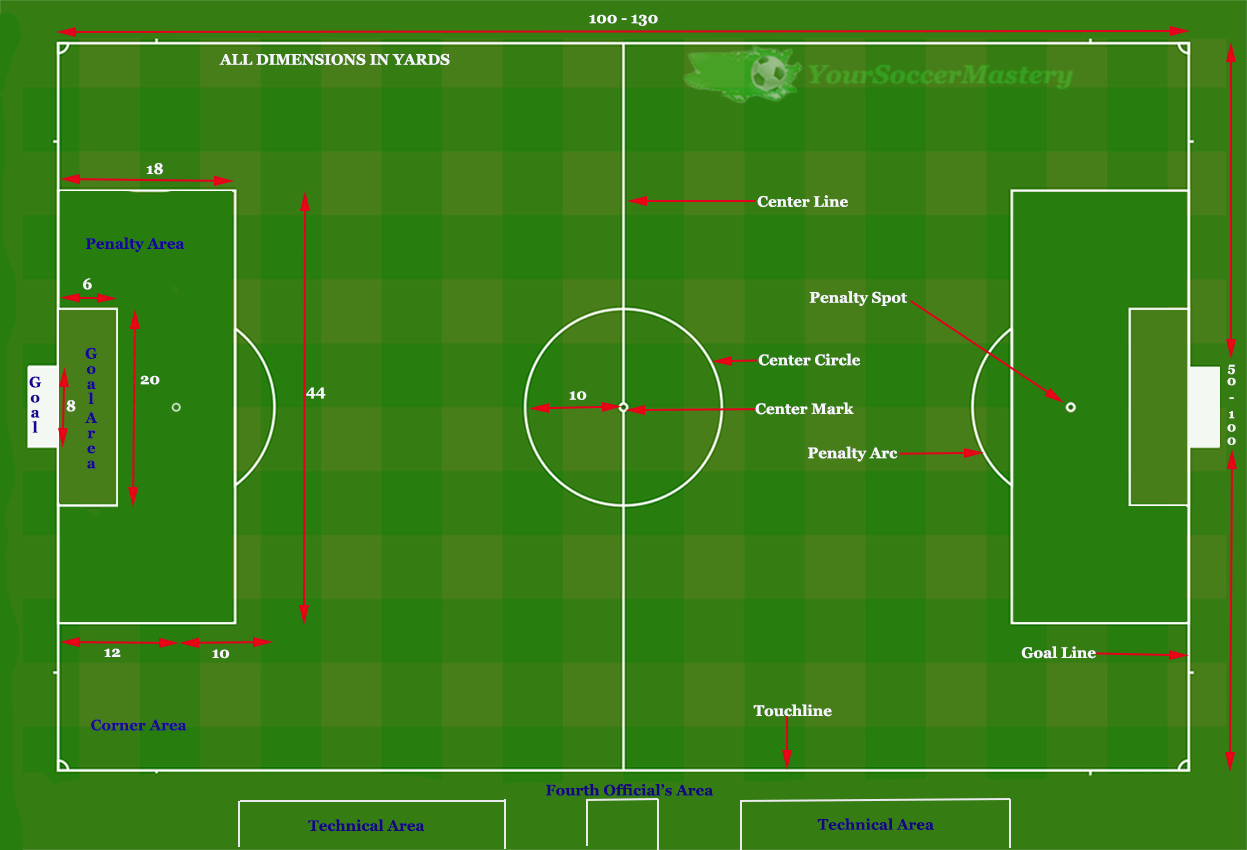Are you a soccer player or fan who wants to learn more about the entire layout, structure, and dimensions of a soccer field to improve your understanding of the game? Good news! You have landed on the right article because it is imperative to understand the different soccer pitch areas, it’s dimensions, and markings.
So, having a good knowledge of the soccer field will unbelievably improve your field awareness as a soccer player and makes the game more interesting to you as a soccer fan.
Indeed, this article will share a simplified guide to all the different soccer pitch areas, the soccer field layout, and all its dimensions and markings.
Equally, you will learn the different types of spot-kicks and where we take them on the soccer pitch. We will also explore all the basic rules governing play in every area of the soccer field.
“What are the soccer field dimensions? How big is a soccer field? How wide is the 18-yard box in soccer? What are the youth soccer field dimensions? What is the radius of the center circle? What are the dimensions of the soccer field? “
These questions and much more, I believe, are some of the uncertainties you may have and which I hope to address in this article. Are you ready for the fun ride? Let’s get right into it.
The soccer field touchline and goal line
Are all soccer fields the same? The simple answer is no. As a matter of fact, the soccer field also referred to as the pitch, is a rectangular area that defines the confined space in which we play the game. Equally, the area is bounded by the touchline(the length), measuring between 100 yards and 130 yards, and the goal line(the width), which is between 50 yards and 100 yards.
Truly, the field’s size depends on the age level, the soccer competition, and the country’s FA rules. Additionally, soccer organizations implement acceptable reference ranges to field sizes. As a result, the kids’ pitch, the youth field, the college, and even the pro-level soccer fields vary per the competition rules.
How are the touchlines and the goal lines utilized?
The touchlines and goal lines are the peripheral lines that enclose the soccer pitch. So, when the ball goes out of bounds, the play has to be restarted in one of two ways.
Firstly, when the ball crosses the touchline, we take a throw-in for the restart of play. The team player who touched the ball last before it crosses the touchline turns over possession to the opponent team.
secondly, when the ball crosses the goal line but doesn’t end up in the goal, a corner kick or a goal kick is taken depending on the last touch. The referee awards a goal kick when the ball comes off a player in the attacking team over the opponent’s half of the field’s goal line. Also, a corner kick results when a defending player blocks or kick the ball over their half of the field’s goal line.
Ultimately, all players while trying to make plays towards scoring goals for their respective teams have to keep the ball within the bounds of the field.
The center of the field
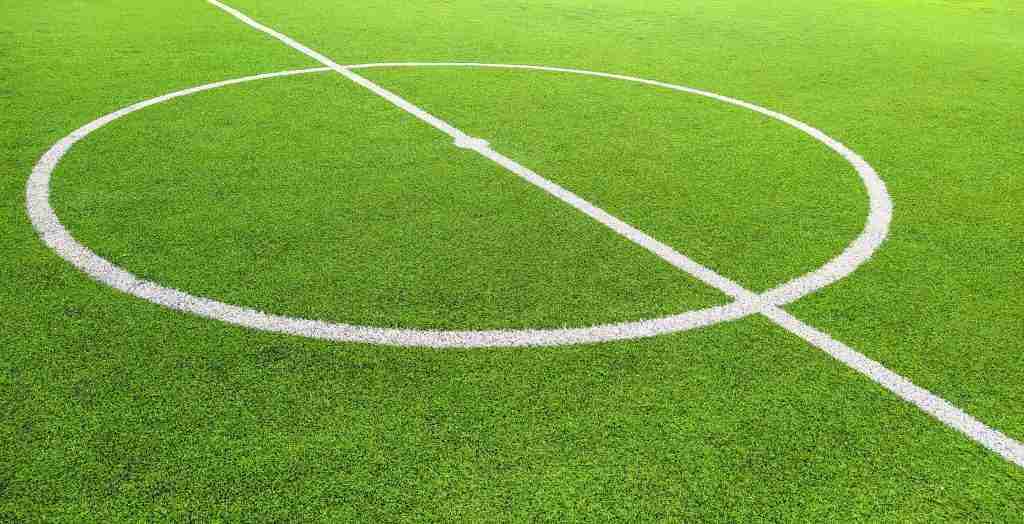
On the soccer field, the centerline splits the field into two halves and is drawn from touchline to touchline. At the midpoint of the centerline is the center mark. In addition, there is a center circle of radius 10 yards from the center mark(20 yards in diameter).
Now, what is the use of a center mark? Well, play originates from the center mark in four different situations as listed below:
- Firstly, at the kickoff or start of a game.
- Secondly, at the beginning of the second half of a game.
- Thirdly, at the start of the first and second halves of extra time.
- And finally to restart the game after one team scores a goal
What is the purpose of the center circle of a soccer field?
There is a reason for every marking on a pitch, right? The center circle marks the minimum distance where the players can be from the center mark before the start or restart of play. So, only the player(s) taking the kickoff are allowed in the circle, but all players can run into the circle after the game starts.
Now that you have learned about a soccer field’s borderlines, let’s look at the field’s most exciting areas. We will take a closer look at the penalty area, the goal area, and the goal. Those are the most decisive areas in a game, making it imperative to understand how players play in these areas and the dimensions.
The soccer field goal
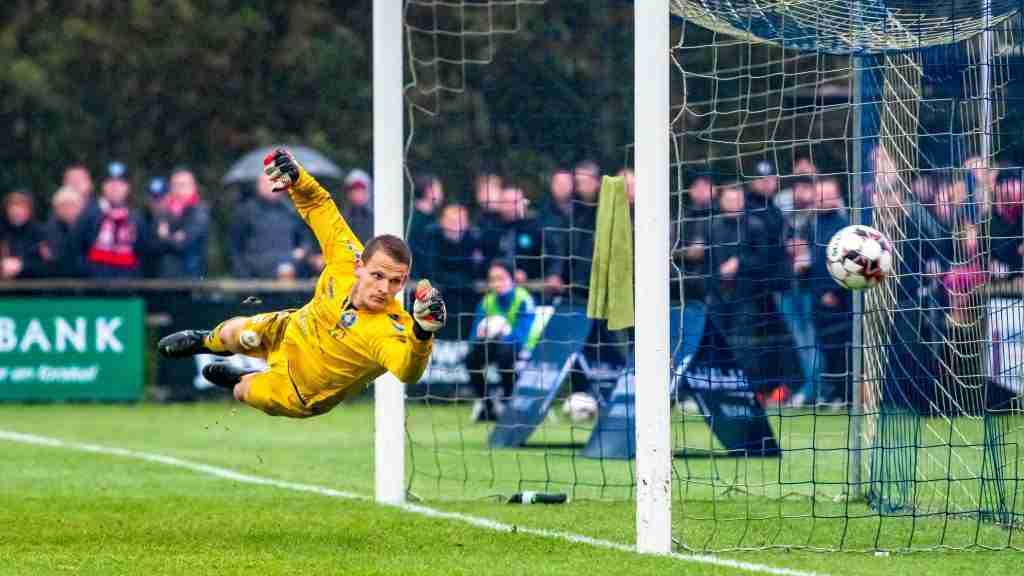
The soccer goal consists of two goalposts( firmly anchored to the ground) and a crossbar placed at the goal lines’ midpoint. Specifically, the goalposts are 2.66yards(8ft) long, 8 yards apart from their interior edges, and are equidistant from the corner flags.
In fact, the crossbar links both goal posts at the right angle. It is as well important to note that the goals must be painted white.
After all, all these soccer goal dimensions are regulated by the World Football Federation (FIFA) or by competition-specific organizations.
How does a player score a goal?
A player scores a goal when they kick or head the ball across the goal line into the area bounded by the goalposts and the crossbar.
Also, soccer nets are typically attached to the goals and extend outwards from the goal line area to keep the ball contained when a player scores. These nets must be firmly attached to the goal to make sure there are no holes through which the ball can escape when the player scores.
In fact, proper attachment of the nets confer easy decision making by the officials and promotes fair play.
I have been to a kick up game where the referee controversially ruled out a goal because nets were not used. Such an occurrence can be very frustrating to the scorer and his team and relieve the opponent team.
Frankly, it is hard to tell from a significant distance whether a ball goes through the goal or goes wide without a net in place. Don’t you think?
The goal area of a soccer field
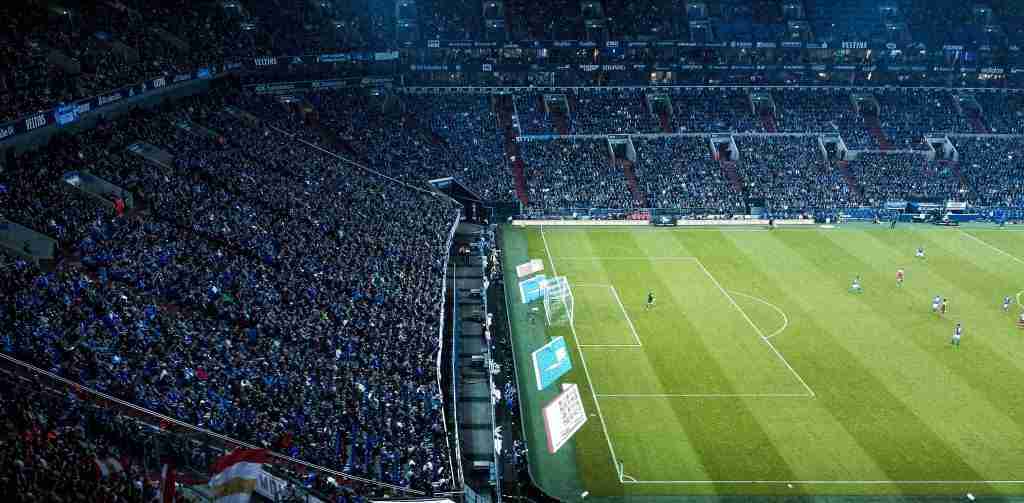
The goal area is the area bounded by two lines drawn perpendicular from the goal line. Also, the lines extend 6 yards into the field of play and are connected by another 20-yard line at the right angle to them. You may be wondering what use it is placing the goal area on the pitch.
Actually, the goal area marks the limits to where a player legitimately takes a goal kick, which is anywhere within the goal area. Pro goalkeepers typically place the ball at the 20-yard line of the goal area.
The penalty area
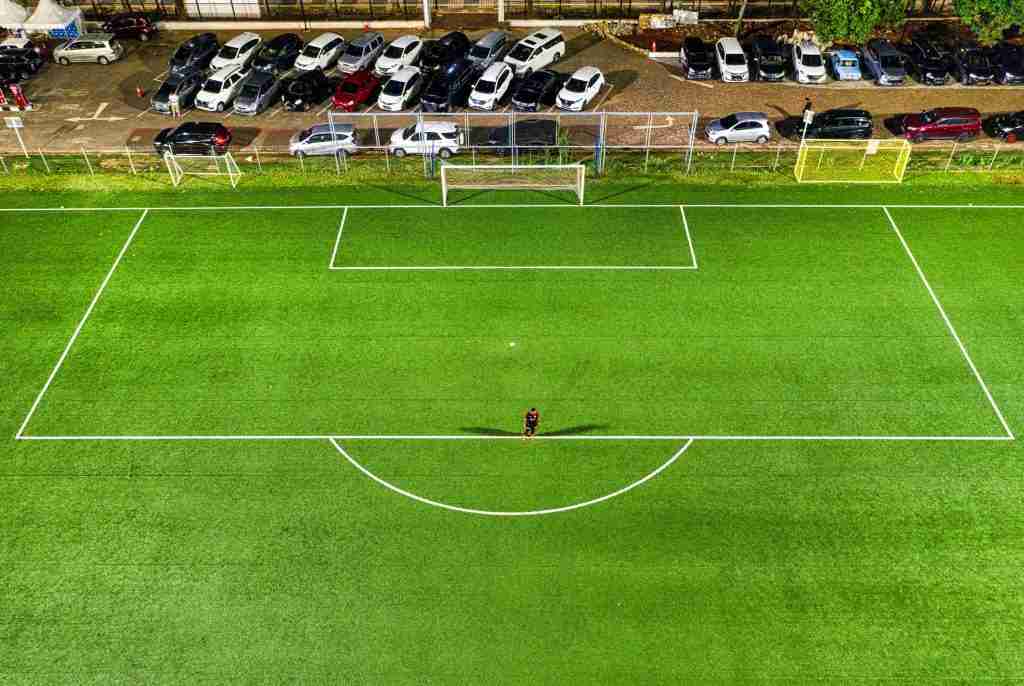
The penalty area is the rectangular area 18 yards long and 44 yards wide extending from the goal line. Therefore, it encloses the goal area.
During gameplay, the attacking team strives to get into the penalty area to increase their chances of scoring a goal. The defending team closes down on the attackers to keep them out of the penalty area.
Certainly, universal soccer rules protect goalkeepers within the penalty area regarding physical contact with an opposing team’s player. Likewise, the penalty areas also are the only areas where goalies are allowed to handle the ball.
That said, if an attacking player gets fouled within the penalty area, the referee awards a penalty kick to the attacking team. Any player of the attacking team can take this spot-kick from the penalty spot.
Indeed, the penalty spot is a marking within the penalty area 12 yards from a point midway between the goalposts.
Additionally, there is a penalty arc drawn 10 yards from the penalty spot. The penalty arc is marked along the edge of the penalty area on the line parallel to the goal line.
During a penalty kick, only the penalty taker and the goalkeeper are allowed in the penalty area before the kick is taken. In other words, every other player must be beyond the arc and the penalty area. The penalty arc purposefully maintains at least a 10 yards distance from the ball to the rest of the players before the penalty kick.
The Corner area of a soccer field
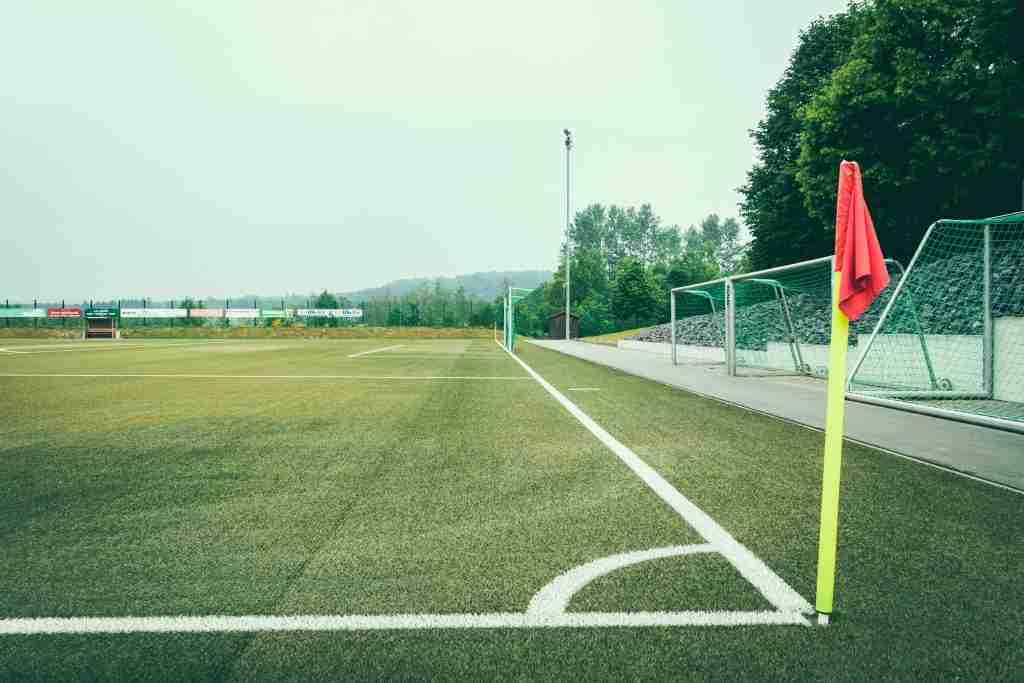
As the name implies, the corner area is formed by the right angle between the goal line and the touchline. Also, a quarter-circle called the corner arc of radius 1 yard is drawn on the field of play to complete the corner area.
In addition, there is a corner flag, typically about 5 feet high, pinned to the ground at the corner area’s edge. The tip of the corner flag has to be non-pointed. In a game, we take corners from this area. The ball should be placed anywhere within the arc or on the arc line to take a corner kick.
It is worth noting that the two halves of a field are mirror images of each other. Both halves have the same dimensions, markings, and the same unique visual look.
Having learned all the dimensions, field areas, and how we play in those areas, let’s now talk about specific field sizes determined by the age group, the organization, and the competition rules and regulations. You will learn the college, the high school, and the youth level field sizes.
The College Soccer field dimensions
The college soccer field measures between 70 and 75 yards wide, and between 115 and 120 yards long. The dimensions are set by the NCAA (National Collegiate Athletic Association), making sure the field sizes are well within the organization ranges.
The youth soccer field dimensions
Truly, the age group of the players determines the youth field sizes. In fact, they are smaller than the standard adult level fields. You certainly don’t want to have a 6 to 10-year-old running around in an oversized field since youth pitches are mostly recreational.
For instance, there are tons of youth soccer competitions every summer for kids to catch some fun playing before the school’s resume. The table below summarizes the age group dependent field sizes. With this in mind, the second column represents the percentage of the size of the youth field relative to the adult field sizes.
| Age Group | % Adult Size | Field size(Yards) |
| U-14 | 100% | 60 x 100 |
| U-12 | 80% | 50 x 80 |
| U-10 | 70% | 40 x 70 |
| U-8 | 50% | 25 x 50 |
| U-6 | 25% | 15 x 30 |
United States High School soccer dimensions
The NFHS (National Federation of State High School Associations) set the range of high school field sizes to between 55 yards and 100 yards wide and between 80 yards wide and 120 yards in length. Of course, every school has to stay within the acceptable range for compliance but doesn’t have to be the same.
The soccer field play surface
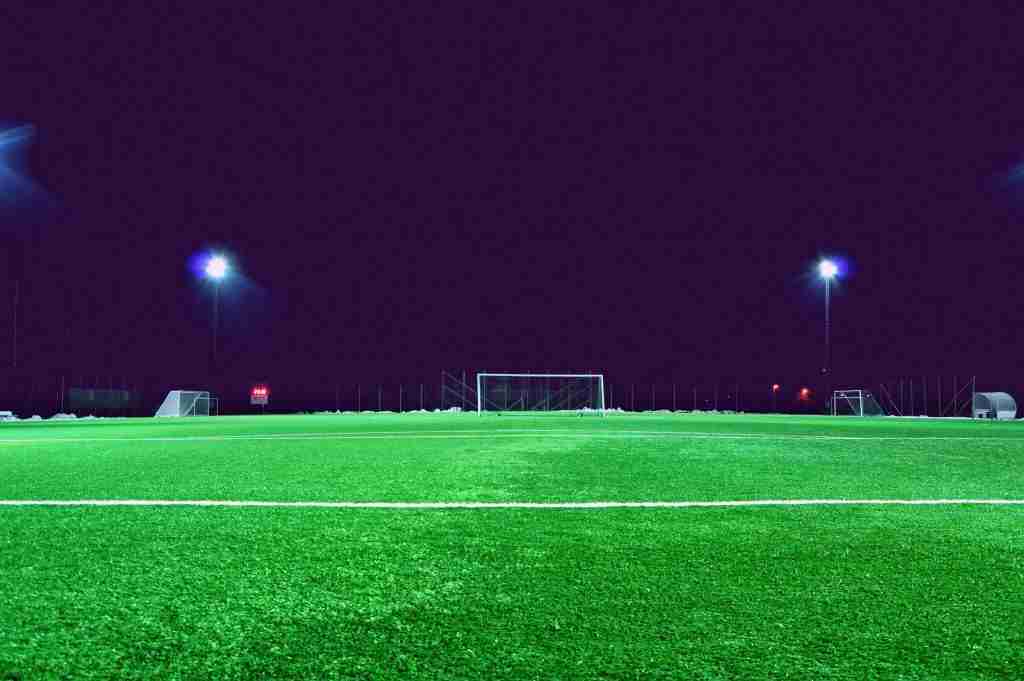
Natural grass or artificial turf?
Artificial turf surfaces are made from synthetic grass, usually manufactured in green. On the other hand, fields with natural grass are grown under their natural growth conditions just like our backyard lawns.
In fact, the vast majority of soccer fields nowadays use natural grass. Consequently, almost all FIFA regulated fields, and most professional club fields utilize natural grass.
I’m sure it isn’t a surprise to you that there is also a high maintenance cost that comes with natural grass fields. To put it briefly, they have to be watered, pest controlled, mowed, and remarked so often.
Why are soccer fields watered before a game and at half time?
In fact, wetting the surface moistens it and enables the ball to move quicker than when the surface is dry. In a similar fashion, a moist surface provides a fantastic playing condition to teams that like to move the ball fast in possession.
Typical examples of pacy possession-based teams are Barcelona FC and my favorite club Manchester City FC. Whereas, dry surfaces closely mimic the artificial turf, which is less safe as I will substantiate in just a minute.
Artificial turf is more popularly used on indoor soccer fields, which have different field safety rules from the more popular outdoor soccer. Therefore, the turf doesn’t demand a whole lot of care compared to natural grass. That’s why turfs are used in covered fields to prevent any damages from rainwater. Click here to learn more.
So, why is natural grass more popularly used worldwide even though it is costly to maintain?
The most important benefit of natural grass over artificial turf is with regards to safety. “Safety first,” right? Just like the rules of the game get amended, soccer governing bodies pay close attention to players’ safety in games. So the choice of grass over turf is no surprise.
According to a research conducted by the University Hospital Sports Medicine Institute and the Case Western Reserve University in 2017-2018, college athletes had a 58 percent more risk of sustaining injuries on all athletic activities on artificial turf than on natural grass.
Findings also show an elevated rate of ACL injuries in football athletes(not soccer) on artificial turf compared to grass. In a nutshell, natural grass is a much safer option, in my opinion, on soccer fields than artificial turf.
The white markings on the soccer pitch
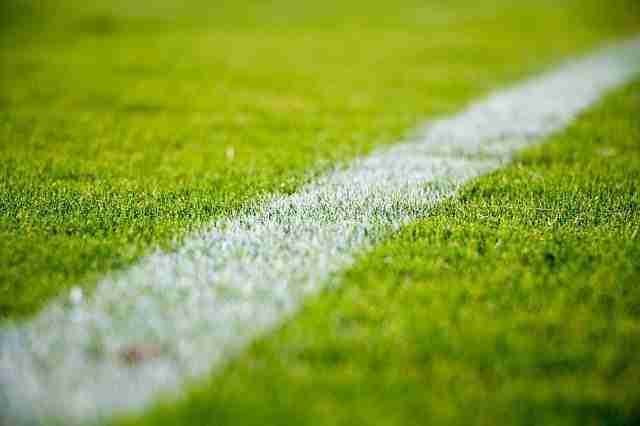
Freshly mowed fields are marked with paint to produce all the lines we see on the field surfaces. Indeed, the thickness of all the lines on the soccer field is the same. More importantly, the lines are about 4.7 inches thick and match the goalposts and crossbar’s thickness, which are painted white as well.
As we discussed earlier, the center mark is the midpoint of the centerline. The center mark is about 9 inches in diameter. Also, the penalty spot marking is an inch smaller than the center mark at 8 inches in diameter.
Having learned about the field of play, let’s now explore the other areas off the pitch. I will take you through the technical areas and the fourth officials’ designated location. These areas, of course, are clearly defined in a typical stadium setting.
The technical area and the 4th officials’ area
The technical areas are designated seated areas for the coaching staff, medical team, and substitute players. These areas are located on both sides of the center line and the same side of the field. Each team is assigned one technical area. They are rectangular areas that project from the designated seated area up to about 1 yard from the touchline.
Managers or coaches roam around within the marked areas to provide instructions to their players. They are not allowed to leave their technical areas when a game is going on.
In a similar fashion, the medical team only leave the technical area by the referee’s instructions to attend to injured players.
The area between the two technical areas is the neutral area occupied by the fourth assistant referee. The fourth assistant referee oversees player substitutions and indicates additional times after the ends of every half and extra times. They also ensure that the benches stay disciplined throughout the game.
Conclusion
Thank you for going through this article. Like you must have understood from this article, being a terrific soccer player takes a lot more than just physical practice with a ball. Therefore, you have to have a comprehensive knowledge of the soccer field which again will improve your field awareness and vision.
I trust this article helped you understand the structure of soccer fields. If you have any questions or contributions please feel to reach out by filling out the form on my contact page. I will be more than happy to help.
I have prepared the Soccer Field Layout Free Guide as a pdf chectlist that you can download and print to use for quick reference to mastering the soccer field. Fill the form below to download.

